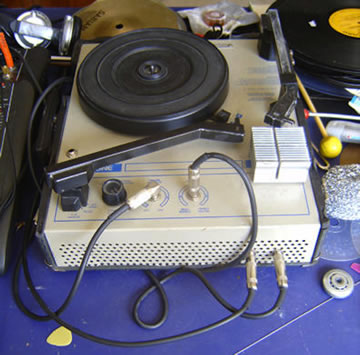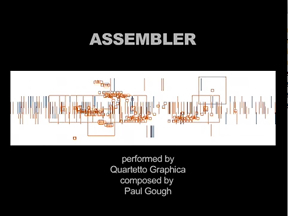The Turntable is Dead, Long Live the Record Player
I do play a record player. I have a large selection of various record players, all of them are used and a great number are of the institutional variety, from schools and dance studios or bought on eBay, at the Sally Anne and junk shops. I love the old self-amplified record player. I cannot stop buying them; they are an object of great beauty to me from their indestructibility, their shape and most of all, the inviting form of their function. This is analogous to a great work of art, I can’t take my eyes off it.
I grew up with a turntable along with the television. This was the focal point of one’s entertainment life. The record player/turntable played a pivotal role in most households, affordable and fashionable. In many instances the stereo components, of which the turntable was of the utmost importance came combined in a console with a television set. Just to veer off for a second, I have heard many people brag about not owning a television but I have never found one who boasted, at this point in time, about not having a record player or turntable. This unit, be it the console, components or a record player, brought entertainment to the masses. Both white and blue-collar households were able to share in the reality of affordable vinyl records as cheap and essential entertainment. The idea of entertainment for all in the comfort of one’s own home became the legacy of the turntable. Before this time the gramophone and the cylinder were the household items and in some instances did more than just feed ephemeral media into ones existence it could capture the aural actions of a participant. Some people and the clergy accused these machines as stealing and capturing the spirits of the participant thus becoming a tool of Satan, as it invited the voices of the dead to be brought into the life of the living. This was believed to be a satanic act or, as Nicolas Collins referred to it, the Devil’s Music.
Now, you may ask what does this have to do with the artist, the record player, turntable, electroacoustic music and me? How does a once everyday device become a catalyst for electronic new music? It has a specific function. Its purpose has been designed and lived by for decades?
The record player/turntable went through a metamorphous, its tides turn, being eliminated in society as the entertainment machine replaced by digital media. The turntable’s function changed in flux with the societal digitization forced on the world’s populace; it became instrument. The records that filled the shelves in the living rooms and rec rooms went the way of the typesetter, from prestige to irrelevance, practically overnight. Digital media became the societal entertainment.
The turntable/record player lost it status as an entertainment provider transforming by being reborn as the entertainer. The turntable evolved from shelf to stage. I believe the general populace see this evolution having taken place in the early 1990s, as hip hop or rap started to move from the projects in the United States to radio and the dance floors. Even those who have a better understanding of the turntable as instrument may equate its history back to the late 1970s and the work of DJ Kool Herc or Grandmaster Flash. But the clock goes back much farther. The record player was reinvented as a tool for experimentation, awakened by the avant-garde. This was an early reconfiguration of the everyday. Cage started to reinvent purpose by dismantling the record player. It happened with Cartridge Music, where, as the title suggests, the needle and cartridge of the player are scraped and tapped against various objects dissolving the function and the form of the player. Fully redefining its purpose. Thus, opening a Cagian, or should it be a Duchampian doorway to an electroacoustic innovation. The record was no longer needed to play a role in the function of the record player. The player itself became the instrument or the egg in this genesis into the exploration of the everyday. Cage was able to rewrite the usage, which in the past and still to this day required the record, the vinyl or the information.

The DJ from DJ Kool Herc to today needed to know their records: the correct place to find the information needed to provide the sounds necessary. This placed the turntable and the vinyl record as an instrument of intent. Knowing one’s music and where beats and licks were to build a new song that invited spectators to dance to these new collaged forms of music. Room for experimentation was hidden by the commercial and commerce-based new intent of this musical form. Running parallel to this innovation in the turntable’s new history and relevance are also the experimental artists or turntablists, Christian Marclay being in some ways seminal. He takes a Duchampian approach to the record player and records by recontextualizing the player’s purpose and also causing us to re-examine the information found on a record or data source. This new thesis encouraged ideas such as the surface sound or noise to be as valuable as the information pressed on it. That scratching a record, by this I mean to drag a needle across the record, rather then using a found sound and playing it back and forth became a legitimate form of noise/sound creation. The using of a found record without the previous knowledge of its content to be used, stood against the necessary knowledge needed to be a DJ/Turntablist for the dance floor. This allowed for improvisation by taking away intention on the part of the performer/artist.

The deconstruction of the record player has become the primary source of electroacoustic instrumentation for me. I find records fascinating and use them still within my œuvre, but it is the ability of the player to create its own sound that has inspired my practise. I have placed a variety of contact microphones into the body of my institutional record player. By doing this I am able to extract sounds from the player. Also, it allows me to use the body of the machine as a sound creation board. I am able to drag, bow and use objects to create noises not associated with the player. I have also incorporated a heat sync from a computer to work as another tool for generating sound. The heat sync has a series of metal dividers and spaces in between, this invites plucking of the dividers and the placing of objects into the spaces. These objects become fodder for experimentation.

The sounds are sent from the player to a mixer where they are processed or sampled through a couple of effects pedals. I presently use two Kaoss Pads. They allow for sampling and manipulation of the sounds received. The Kaoss pads can also be manipulated to play into themselves, based on the revolution of the no-input mixing board phenomenon. The manipulation of the Kaoss pads to feed off themselves also allows for the sound arriving to the board from the source or samples to be distorted and regenerated through the Kaoss Pads’ feedbacking on itself.
The re-directing of the effects pedals into itself, escapes its own intent. Destroying a priori coding of its purpose. This is evident in its almost uncontrollable attack of noise. I feel I work in an extension of the electroacoustic field, but one based on improvisation rather than composition. This field is becoming known as EAI, or electroacoustic improvisation. This can be described as fitting the notions of improvisation with its lack on intent and escape of composition, still using a formalized instrumentation. In this sense I see EAI as being able to dissolve the instituted truths around electroacoustic meaning. I believe eliminating the academic attitude surrounding the formal aspects of electroacoustic music breathes new life into the form, which many had felt had moved into stagnation and academia.
Now, please don’t get me wrong, I too have played compositions. I play Stockhausen’s Spiral, which I have translated into my own graphic score. I also belong to an EAI-based quartet, Quartetto Graphica, which specializes in improvisational translations of modernist and post-modernist graphic scores. These scores offer the freedom to experiment with its content thus inviting a freeform interpretation of the work. Quartteto Graphica re-structures the scores to fit our instrumentation, laptop, guitar, no-input mixing board and processed record player. I feel the quartet has been able to extend the accepted language and intent of the work, infusing a contemporary function into the form, lending a new purpose.



Assembler n. 1 a person who assembles a machine or its parts. 2 Computing a a program for converting instructions written in low-level symbolic code into machine code. b the low-level symbolic code itself; an assembly language. (Fällt website)
The record player according to me is an instrument that fits the realm of electroacoustics. I’m able to generate sound, which is then processed. I produce sounds acoustically in most instances by using the sound of the machine, proper or by producing sound through the player. This innovation can be attributed to Cage and his fascination with deconstruction and by the techniques used by the improvising community and its need to change the function of its intended instrumentation.

Social top